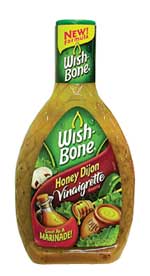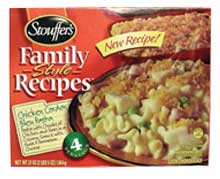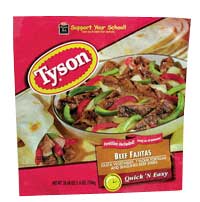
Soy Toy
Considering soy sauce has been used in culinary applications for more than 2,500 years, finding new applications for the ingredient could be intimidating. However, thanks to the fact that soy sauce has some 300 flavor compounds, the task is much less daunting.
Still, it is somewhat surprising to see where soy sauce has been used of late. One such example is a new salad dressing flavor under the Wish-Bone brand from Unilever Bestfoods (Englewood Cliffs, N.J.). The use of soy sauce in a dressing, sauce or marinade is nothing new, but Wish-Bone has included it in a Honey Dijon Vinaigrette flavor and claims the product will work well on salads or as a marinade for chicken or steak. The soy sauce used is composed of wheat flour, water, soybeans and salt.

Soy Different
Widely perceived as a savory flavor enhancer for Asian foods, manufacturers have discovered the many nuances of soy sauce allow its use across a range of ethnic cuisines. Taking the Asian staple into the Hispanic arena, Tyson's (Springdale, Ark.) Beef Fajitas added soy sauce to the beef strips. The soy sauce used here is similar to the version used in Wish-Bone's salad dressing, with one notable, though understandable, addition: the inclusion of sodium benzoate as a preservative. Suppliers will note that soy sauce is a common addition to fajitas, serving to enhance the meat's flavor.
Taking the ingredient in a French direction, Nestle USA's (Solon, Ohio) Stouffer's brand added a dry version of soy sauce to its Family Style Recipes version of Chicken Cordon Bleu Pasta. Described on the packaging as “pasta with chunks of chicken and ham in a creamy sauce with Swiss & Parmesan cheese,” a dry version of soy sauce is used in the product's bacon base, which requires the use of maltodextrin in its preparation.

Soy's Life
Soy sauce emerged in China and its growth was fueled by the vegetarianism of many Buddhists. The desire for a meatless seasoning prompted the creation of a salty paste of fermented grains including soybeans, regarded as the first product to bear a resemblance to modern soy sauce. A Zen priest brought the recipe to Japan, where modifications to the ingredients and brewing techniques led to a soy sauce with what is said to be a more balanced flavor profile, one that could enhance food flavors without the risk of overpowering them.Soy sauce continues to serve as a prime ingredient for those looking to avoid meat. In the new cheeseburger variety of Boca Burgers, Boca Foods (Madison, Wis.) adds soy sauce powder, comprised of soybeans, salt, wheat and maltodextrin. In the process, the meatless burger promises 50% less fat than a ground beef hamburger and 9g of soy protein per serving.
The fermentation process for soy sauce, however, is time consuming and requires months to impart the rich, mellow flavor, aroma and delicate amber color. An option, developed during the 20th century, is to use ingredients derived from the acid or enzyme hydrolysis of various proteins.
In this procedure, hydrolyzed vegetable protein (HVP) is obtained from any of various foods—including soybeans, corn or wheat. Likewise, HVP can be used as a flavor enhancer in such processed foods as soups, chilis, sauces, stews and some meat products like frankfurters. Numerous variations of HVP exist, but one way to categorize them is by color. A light version is likely used in poultry, pork and vegetable products, while its dark cousin can be found in broths, sauces, gravies, meats and stews.
Sidebar: Soy Sauce…a Spectacular Flavor Enhancer
Ranch Dressing. Pasta Salad. Chicken Fajitas. Veggie Burger. Chocolate syrup. Gingerbread. What ingredient do all these foods have in common? Soy sauce. A peek at today's ingredient statements shows a greater presence than ever of this characteristic ingredient and mystical flavor enhancer.For over 2,000 years, soy sauce traditionally has been at the heart of Asian cuisine. Made from soybeans that have been “brewed” (or fermented) over several months, enzymes create amino acids and peptides while breaking down soy proteins. The numerous flavor compounds derived from this process gives soy sauce its unique flavor profile and aroma.
Soy sauce shines in a surprising variety of applications. It heightens the meaty flavor in savory dishes, while adding color and enhancing aroma. It unifies spice flavors in marinades and tempers the harshness of vinegar in salad dressings. In snack foods, it blends together other seasoning ingredients as it also adds salt, color and savory flavor. In lesser-known roles, it blends yeast and grain flavor notes in breads and other baked goods, and even moderates sweetness in confections such as chocolate syrup.
Although soy sauce's appeal may extend to the benefit of a “cleaner” ingredient statement (it often is substituted for the controversial monosodium glutamate [MSG], without usage or application restrictions), it does have some glutamic acid, which occurs naturally during the breakdown of proteins. However, soy sauce only needs to be declared on a food label by name, followed by the ingredients from which it is made.
—Chef Eric Carré, Founder/President, ErdaTek Inc., 877-377-9797, www.erdatek.com

HVP, An MVP?
Considering that HVP is much quicker to process—and, generally, a less expensive ingredient option to gain some of the taste benefits provided by soy sauce—it seems fitting to incorporate it into one of the latest convenience meals. General Mills (Minneapolis) added a version to the Homestyle Dumplings & Chicken variety of Betty Crocker Complete Meals. Although convenient, the product is not necessarily a time-saver, at least in comparison to some of the other, microwaveable meal kits available. After a fairly simple preparation, the dish has to cook for a minimum of 25 minutes. Incorporated into the seasoning blend, the HVP used is derived from soy, corn, wheat and yeast.
HVP can be used as an ingredient on its own, or serve as the basis of formulated soy sauce. This latter product is not without its detractors, many of whom suggest that such HVP-based soy sauces should bear the words “non-brewed” or “short-term brewed.” Already, the Food & Drug Administration (FDA) requires more than just “hydrolyzed vegetable protein” for any such ingredients on the ingredient legend. Regulations require the food label to identify the specific protein source, i.e., hydrolyzed corn protein, for a couple of reasons. The common or usual name of a food must adequately describe its basic nature, characterizing properties or ingredients. General terms such as “animal” and “vegetable” are considered unsuitable, because protein hydrolysates from different sources best serve different functions. In addition, consumers with special dietary requirements need to know the source of the additive.
Turning Protein
During the technical sessions at the 2001 meeting of the Institute of Food Technologists (IFT), one research team unveiled an alternative to acid hydrolyzed vegetable protein. The alternative, identified as enzymatically hydrolyzed vegetable protein (eHVP), used wheat gluten as the raw material “because of its feasible degradation.” Hydrolyzed by koji-culture, the hydrolyzation was in the presence of salts and at high temperature. The reported degradation ratio was higher than commercialized yeast extracts. The odor and color also were weaker than yeast extracts. The resulting eHVP also lacked monochloropropanol and dichloropropanol at the detectable level of 5ppb. Furthermore, the flavor intensity was enhanced two times and four times, respectively, with the addition of 0.001% and 0.003% of nucleic acids. The principals suggested that the eHVP could replace monosodium glutamate, yeast extract and beef extract, as well as HVP.Website Resources
www.fda.gov/fdac/special/foodlabel/ingred.html— Ingredient Labeling: What's in a Food?http://ift.confex.com/ift/2001/techprogram/paper_9433.htm— IFT paper: Development of enzymatically hydrolyzed vegetable protein with koji-culture and its application to foods
www.mindfully.org/WTO/Global-Food-Fight25aug02.htm— San Francisco Chronicle article “Global Food Fight Brews Over Sauce Labeling”
Some of the information in this article was derived from Mintel International's Global New Products Database, www.gnpd.com, 312-932-0400. For more information on the GNPD, e-mail: kthackston@mintel.com

Sidebar: Going Global
A Prepared Foods article in June of 1998 mentioned the emergence of soy sauce as a flavor enhancer for confectionery products, and a recent launch shows the ingredient has, indeed, made its way to Japan's candy aisles. However, the inclusion of soy sauce will not be the first thing to catch the eye. Positioned as a more natural snack, Inside-Out Caramel Potato from Kanebo Foods (Tokyo) is made with sweet potatoes. Diced, deep-fried and coated in caramel, sweet potatoes long have been a favorite in the country, but Kanebo solved one of the big drawbacks to the treats—sticky hands. To prevent this, the inside-out caramel potato has the caramel inside and is coated with sweet potato paste. Retailing for 200 yen ($1.67), the Japanese name for the product is Gyaku Daigaku Imo.
In Ireland, Namchow (Bangkok) has released Rice Cracks crackers, with soy sauce among its ingredients. Lightly salted and gluten-free, the low-fat crispy rice snacks retail for 1.49 euros ($1.39).

Mexican beer drinkers, however, are managing to use soy sauce the way many Americans first enjoyed it, although not likely in the same application. Available from Compañia Alimenticia del Norte (Nuevo Leon, Mexico), Micheladas Miche Mix Especial is a condiment for beer. Among the ingredients are soy sauce, salt, lemon juice and powder pepper.
